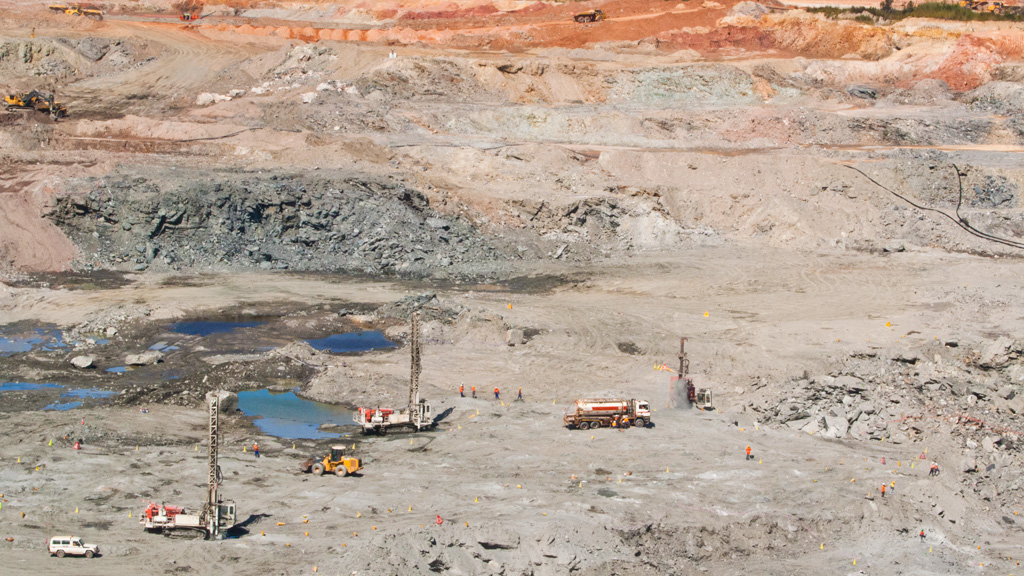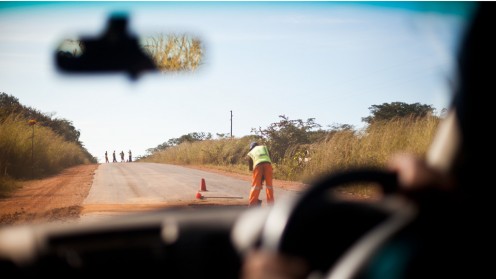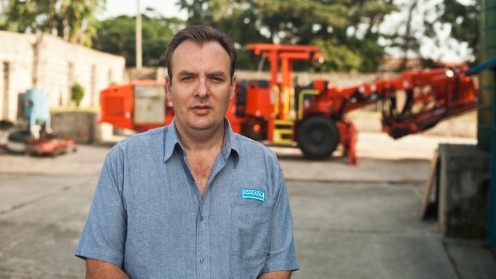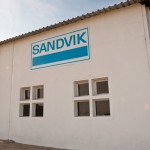Scratching the surface? Not in Zambia
Volatile copper prices, lower ore grades and increasing production costs are fuelling a surface mining boom in Zambia. Sandvik Mining has opened a new regional facility in the North-Western Province to better serve its surface mining customers.
Zambia is Africa’s top copper producer. As the price of the red metal has more than tripled since the country privatized mining in 2000, Zambia’s copper industry has thrived.
Multinational companies have invested almost 8 billion US dollars in new and old copper mining projects since privatization. Two years earlier, Zambia’s copper output had fallen to an all-time low of 228,000 tonnes. Today, Emmanuel Mutati, president for Zambia’s Chamber of Mines, says the country’s annual copper output could double to 1.5 million tonnes within three years thanks to new mining projects being developed — an increase that would boost Zambia from its current spot as the world’s seventh-largest producer to fourth.
Most of the country’s copper is extracted in the Copperbelt, a prolific mineral-rich area of Central Africa that stretches across northern Zambia and the southern Democratic Republic of Congo. It’s among the largest and highest-grade sediment-hosted copper zones in the world.
As Zambia’s copper production has steadily increased since privatization, so has Sandvik Mining’s presence along the Copperbelt.
The company has been the single-largest supplier of underground equipment to the country’s copper mines for 15 years. Sandvik has served its customers out of a head office and service centre in Kitwe, the industrial hub of the Copperbelt, for more than 20 years.
In 2005, Sandvik became the first equipment supplier in the Copperbelt to open a technical training academy. The academy trains both Sandvik’s own employees and artisans from mines in the region. It offers customized professional courses covering basic electro/hydraulics, brakes, engine maintenance and monitoring, drive train, drifters and drilling hydraulic control systems, as well as machine-specific courses on Sandvik drills and loaders.
Andrew Maree, Sandvik Mining’s business development manager for Central Africa, oversees a territory that includes Zambia, the Democratic Republic of the Congo (DRC), Republic of the Congo, Malawi, Central African Republic and Gabon. Zambia and the DRC together make up 90 percent of the total Central Africa business, with Zambia alone accounting for 75 percent.
“We’ve put an average of 100 machines into service in Zambia every year over the past three years,” says Maree, one of only eight expats among 340 Sandvik Zambia employees, most of whom are Zambian nationals. “We must have 500 operating machines in this market by now. The aftermarket support required to take care of that number of machines is huge.”
Kitwe is surrounded by older underground mines, many of which are mining copper two kilometres deep and have higher production costs.
“A lot of the deeper mines that have lower copper yields are more sensitive to price shocks,” Maree says. “Obviously, if you’ve got nice yields of 4, 6 or 8 percent, you’re more resilient and you can absorb a lower price. Some copper mines are running at less than 1 percent yield, so the low grade combined with a volatile price can make them fairly marginal, and you need to turn every penny over twice to make sure you’re doing things properly.”
Many mining companies looking for cheaper methods of extracting Zambia’s massive copper reserves are trending towards lower-cost open pit operations around Solwezi, the capital of Zambia’s North-Western Province.
“Nearly 95 percent of surface copper mining happens around the town of Solwezi, making it a strategically significant region for Sandvik,” says Rob McMaster, head of Sandvik’s surface operations in Central Africa.
Sandvik has a large fleet of surface drills in the province, including more than two dozen rigs at First Quantum Minerals’ Kansanshi mine, a dual-pit operation that began production in 2005 and is Zambia’s largest and the world’s eighth-largest copper mine. First Quantum Minerals expects its Zambia copper output to almost double when its Sentinel mega mine, part of the Kalumbila Trident project, becomes fully operational within the next two years.
Sandvik also has a longstanding relationship with Barrick’s Lumwana mine, where it has had a maintenance and repair contract and a separate rock tools contract since 2008. More than 70 Sandvik employees on-site at Lumwana support a fleet of Sandvik D45KS blasthole rigs, Sandvik DP1500 tophammer drills and three recently purchased Sandvik DR560 DTH drills.
Sandvik has been supporting all those drill rigs from Kitwe, but the company opened a new branch in Solwezi in September 2013. Jacques Britz, managing director of Sandvik Zambia, says the expansion is a natural evolution for the company.
“The strategy around Solwezi is to get closer to our surface mining customers,” Britz says. “Our surface mining customers are all in the north-western region of Zambia, and we need to be closer to them and be able to support them within a couple of hours.”
The drive west from Kitwe to Solwezi is only 225 kilometres, but the roads are in poor condition and the drive can easily take up to five hours. The new facility, situated on the road to the Kansanshi mine, will serve as the base for regional field service staff. Sandvik will house all spare parts and surface drilling consumables at the facility, which is much closer to the customers who need them.
“It’s about travel time, but it’s also about safety and practicality,” Maree says. “If you’re going to cut down on delivery times, you’re going to give your customers much better service. Opening this branch enables us to respond quicker to our customers’ needs.”
The Solwezi facility includes a small workshop and offices for the area manager and field service staff.
As many as 100 technical personnel and other employees working on various contracts throughout the region will eventually report to the Solwezi branch.
“Our customers are very careful of their investments going forward,” Britz says. “There’s a lot of focus on cost control, and that’s where we are starting to play a big role — to help our customers to reduce their cost per tonne or cost per metre. Our presence in Solwezi will add even more value for our customers by improving our aftermarket support.”

/https%3A%2F%2Fsolidground.sandvik%2Fwp-content%2Fuploads%2F2013%2F09%2FScratching_the_surface2.jpg)
/https%3A%2F%2Fsolidground.sandvik%2Fwp-content%2Fuploads%2F2013%2F09%2FScratching_the_surface31.jpg)
/https%3A%2F%2Fsolidground.sandvik%2Fwp-content%2Fuploads%2F2013%2F09%2FScratching_the_surface1.jpg)
/https%3A%2F%2Fsolidground.sandvik%2Fwp-content%2Fuploads%2F2013%2F09%2FScratching_the_surface4.jpg)




/https%3A%2F%2Fsolidground.sandvik%2Fwp-content%2Fuploads%2F2023%2F05%2Fth665b_001.jpg)
/https%3A%2F%2Fsolidground.sandvik%2Fwp-content%2Fuploads%2F2023%2F05%2FLH518iB_03437.jpg)
/https%3A%2F%2Fsolidground.sandvik%2Fwp-content%2Fuploads%2F2023%2F05%2Fmodule-high-res_Frilagd.png)
/https%3A%2F%2Fsolidground.sandvik%2Fwp-content%2Fuploads%2F2023%2F05%2FADLA230201_060.jpg)
/https%3A%2F%2Fsolidground.sandvik%2Fwp-content%2Fuploads%2F2023%2F01%2FBackground-2-e1674718920429.jpg)
/https%3A%2F%2Fsolidground.sandvik%2Fwp-content%2Fuploads%2F2023%2F01%2FSmart-parts_2_1600x750.jpg)
/https%3A%2F%2Fsolidground.sandvik%2Fwp-content%2Fuploads%2F2022%2F12%2FADLA211207_070_2500px.jpg)
/https%3A%2F%2Fsolidground.sandvik%2Fwp-content%2Fuploads%2F2022%2F08%2FADLA211214_059.jpg)
/https%3A%2F%2Fsolidground.sandvik%2Fwp-content%2Fuploads%2F2021%2F04%2FKiruna_132_1600x750-1.jpg)
/https%3A%2F%2Fsolidground.sandvik%2Fwp-content%2Fuploads%2F2021%2F04%2FLH518B-Front-Left2_1600x750.jpg)
/https%3A%2F%2Fsolidground.sandvik%2Fwp-content%2Fuploads%2F2021%2F10%2FDSC_2445_B_1600x570.jpg)
/https%3A%2F%2Fsolidground.sandvik%2Fwp-content%2Fuploads%2F2021%2F09%2FTH550B-24m-heading-swap0000_1600x570.jpg)